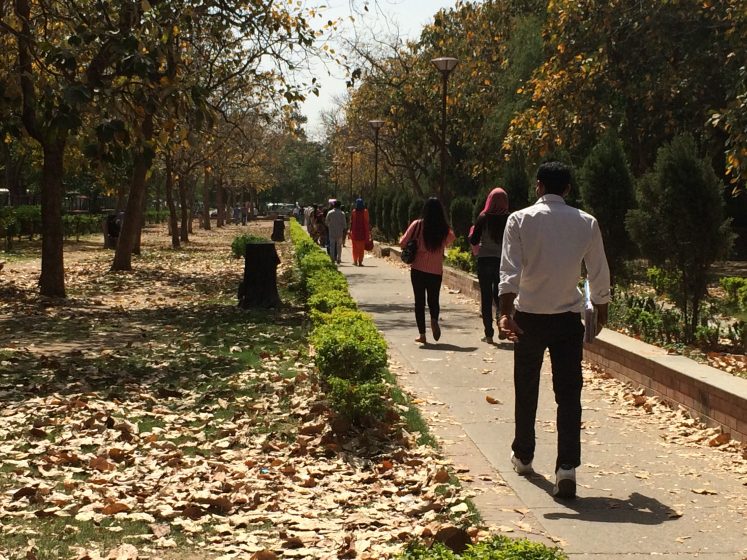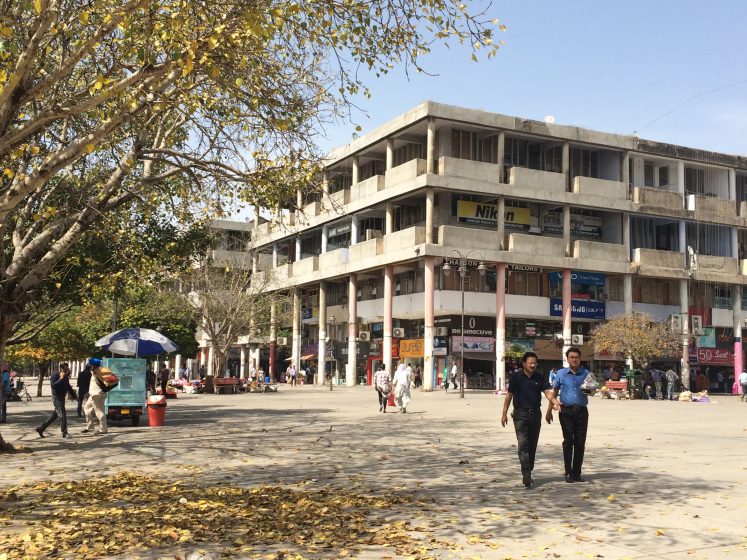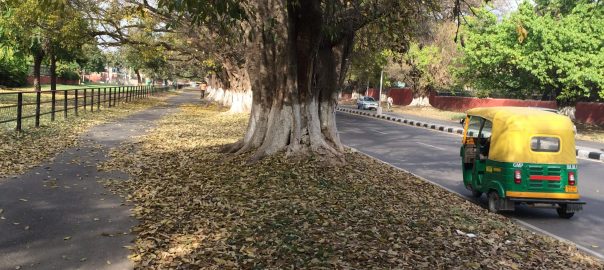I slump into the sofa of the hotel lobby. It’s been another exhausting day walking through India.
Across South Asia, an essential ingredient of livable cities—thoughtful urban planning—appears to be missing.
We squeezed ourselves through narrow alleyways where bicycle carts, cows, and mopeds also wrestle to move a few feet forward. We sidestepped the foil cookie wrappers, paper tea cups, plastic flour bags, and banana-leaf plates swept into a pile by an old, hunched over woman using a broom as tall as her thighs. We tripped over broken asphalt, got shoved by crowds of people rushing through the market, avoided eye contact with packs of barking street dogs, and stepped in cow dung. We managed to stay off the main road in and out of the city, where maniacal drivers aggressively fight for every inch of driving space—yet, the echoes of auto rickshaw, car, bus, and truck horns bounced in our ears. We would have loved to sit in a park, but none were to be found in the urban jungle of dilapidated buildings, colorful temples, and textile factories.

At this moment, we happen to be in the sacred historical city of Varanasi, where locals and people from around the world come to behold and bathe in the sacred (and polluted) Ganges River. But, really, after six and a half months on the subcontinent, we could have been in almost any Indian or Bangladeshi city. They all have this sense of urban planning hopelessness that’s hard to brush off with the ready-made excuse, “Oh, that’s just the way this part of the world is.”

Alfons, the Dutch traveler sitting besides me, confirms this feeling.
“What would you do to make this city more livable?” I ask him on learning that he is a retired urban planner.
“I would raze everything and start over,” he said—half-joking, but not really.
Sadly, if filtered through our Western standards of livability and our hopeful thoughts of urban areas as sustainable, resilient, and walkable places where citizens have access to green spaces, safe public transportation, and transparent governance, many cities in India and Bangladesh would fail the test.

The same frustration holds for planners, architects, and thinkers currently working in the region. When I asked TNOC contributor P.K. Das, a Mumbai-based architect-activist, via email how urban planning fits in the mindset of Indian city officials and the residents they serve, he wrote that “a peculiar Indian cocktail of a skewed, market-oriented development mantra and dominant real estate business is steadfastly breaking down our cities and towns to anarchy and chaos.” As a result, “planning and urban design are farfetched ideas.”
He continued:
The overwhelming thrust towards real estate business is steadfastly eroding larger public interest and colonisation of public assets, thereby leading to the slummification of Indian cities.
Interestingly in India, planning of cities are mostly reflected in the preparation of Development Plans of cities (DP). These plans are reduced to mere land-use maps with a maze of colours for different uses without any urban design vision. Neither do they reflect in any way the needs and demands of most city people. The various coloured blocks are then tossed around freely to suit the ruling class demands. DP’s of cities are backed by development control regulations (DCR). Governments including empowered senior officials have powers to change the various provisions in the DCR time and again. In this process, public participation that is highlighted as a requirement in the process of preparation of the DP and the DCR are given lip service. Public opinion for every amendment is called for, but not generally not accepted.
Neither is public dialogue in such matters considered important. Sadly, this process has reduced public understanding of city planning to the preparation of DCRs. There is a bigger issue, the commitment of governments in India to free market and new-liberal policies has in fact encouraged such a backward development trend. Markets must decide the priorities of development. This is also why governments are not giving priority to planning. Freedom of the free market is the mantra, adding a deadly poison to the cocktail.
But, that’s not to say there aren’t examples of cities, regions, and countrywide improvement projects to point to and after which other cities might model themselves. See also following slideshow, “India Under Construction”.
https://www.youtube.com/watch?v=PW72WaZxcVg
An imported idea worth embracing
While the mishmash of South Asia’s designated “city center” areas may be difficult subjects for urban revitalization and redevelopment initiatives, there are some existing urban concepts that can be extended to surrounding districts and new housing developments popping up around the country.
Chandigarh, the joint capital of the Punjab and Haryana states, offers an example.
The dream city of India’s first Prime Minister Jawaharlal Nehru, it is one of India’s most successful urban planning experiments, according to the city’s website. Built in the 1950s, it’s a unique place in India, and much of that is due to its European roots. Charles-Édouard Jeanneret, the famous Swiss-French architect, designer, and urban planner known as Le Corbusier, planned the city.

Citizens walk on clean, wide sidewalks lined with beautiful trees; bicycles and two-wheelers have designated lanes along main thoroughfares, and traffic flows in a more orderly way than in other cities, through street lights and roundabouts. Chandigarh’s neighborhood sectors are laid out in grid systems, with parks and open spaces featuring as an essential part of the design. There seems to be a good mix of housing and commercial space, alongside a modern bus system connecting different points in the city. There’s even a giant wall map in the main library, pinpointing the locations of other libraries in the cities. Chandigarh has an easygoing, safe, and comfortable feel, and compared to any other city we have passed along our walking route, it is a joy to be there.

Even Indians have a romance with what Chandigarh represents, and seem to wish for similar urban planning successes for their own cities and towns.
A man selling bus tickets in Rishikesh, 200 kilometers away from Chandigarh on the the Ganges River, for instance, cooed when I told him I was heading there.
“Chandigarh… it’s known as the beautiful city. There are so many trees. It’s a pretty city,” he sighed wistfully.
Das actually disagrees. “I personally do not subscribe to gridiron planning,” he told me, specifically citing the style’s accommodations for cars as a problem. “Chandigarh has not been much favoured, nor is it seen as a replicable model,” he said.

Following suit
Still, some of Chandigarh’s design elements appear to be influencing suburban development planning in other parts of India.
We see it happening in the many new housing projects under construction near Gurgaon, which itself has experienced a significant growth spurt in the last few decades, as international companies expanded, benefitting from the proximity of the city to New Delhi and the airport.
The Vatika India Next development offers another example emulating Chandigarh. It is spread across 700 acres of rezoned agricultural space, and is expected to house thousands of families when its various phases are complete. Selling itself as a “city within a city,” the integrated township will have various kinds of residential units (single-family homes; three-story buildings with spacious flats, and high-rise, condo-style apartments), marketplaces, commercial centers, open spaces and parks, schools, nursing homes, hospitals and clinics, entertainment venues, and a road system linking to national highways and major roadways.
The number of cranes, active construction zones, and workers around these newly evolving south Gurgaon sectors—and the many other suburban stretches we walked by—suggests that India’s upward economic mobility is shifting the way people want (and expect) to live.
It looks like locals are also getting tired of squeezing between auto rickshaws and mopeds. Like us, maybe they want to sit in and park, and hear the birds singing, instead of horns honking.
Jenn Baljko
See more about the Bangkok to Barcelona trip here.







Leave a Reply